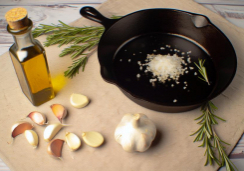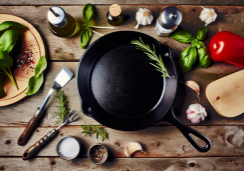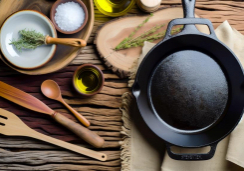What Are Basic Healthy Stir-Fry Methods?
While you might associate stir-frying solely with Asian cuisine, its principles are rooted in an ancient cooking method designed to preserve fuel.
As you explore the art of healthy stir-fry, it's essential to consider not just what you toss in the pan, but how you do it. You'll want to select the right oil—one with a high smoke point to withstand the heat without breaking down into harmful compounds.
Mastering the heat is just as crucial; too low, and you'll end up steaming your ingredients, too high, and you risk charring them.
You're probably familiar with the need for constant motion, but the secret lies in the timing—knowing when to add each component for optimal texture and flavor.
Let's examine how to balance these elements, so you can transform simple ingredients into a vibrant and nutritious meal that's more than just a quick fix.
Will you be able to elevate your stir-fry technique to ensure every dish is not just delicious, but truly wholesome?
Selecting Nutritious Ingredients
When crafting a healthy stir-fry, start by choosing lean proteins like chicken or tofu and an array of colorful vegetables such as broccoli and bell peppers to ensure a nutrient-packed dish. Incorporate a variety of veggies like green beans, snow peas, and baby bok choy to maximize the different vitamins and minerals in your meal.
Opt for olive oil as your cooking fat; although it has a low smoke point, it's a heart-healthy option and retains more nutrients when used correctly. Be mindful of the temperature and add oil just before tossing in your proteins and vegetables to prevent overheating.
Instead of reaching for sauces high in sodium, consider using reduced-sodium soy sauce and fresh herbs to enhance flavor. These choices can help you avoid unnecessary salt intake, which is crucial for maintaining a balanced diet.
Complement your stir-fry with whole grain options like brown rice or quinoa. These grains aren't only filling but also offer additional fiber and nutrients, contributing to a well-rounded meal.
Mastering the Stir-Fry Technique
To master the stir-fry technique, first ensure your wok or skillet is properly preheated to create the ideal cooking environment for quick and even heat distribution. Preheating on high heat is crucial; you can test readiness by flicking a few drops of water onto the surface—if they evaporate within seconds, you're good to go. This high heat allows you to cook small pieces of food swiftly, which not only preserves their tender-crisp texture but also helps them retain more nutrients.
Use a large skillet or wok to give your ingredients plenty of room. A crowded pan can result in steaming rather than searing, preventing that desirable caramelization. With just a small amount of oil, you can achieve the perfect sear on your vegetable stir fry, enhancing flavors without adding unnecessary fats.
Prepare your vegetables and aromatics ahead of time; this fast way to cook waits for no one. Having everything at hand allows you to work efficiently and prevents overcooking.
Perfecting the Oil and Heat Balance
Swirling hot, high-smoke-point oil—like peanut or grapeseed—across the surface of your heated wok ensures an optimal foundation for the high-heat journey your stir-fry ingredients are about to embark on. When you're aiming for a sizzling stir-fry, managing the oil and heat balance is critical. Here's what you need to keep in mind:
- Choose oils with high smoke points, such as peanut, grapeseed, or avocado oil, to minimize low smoke and prevent burning.
- Heat your large wok or skillet over high heat until it's hot but not smoking—this is the sweet spot for adding your ingredients.
- Maintain the heat at a high level throughout the cooking process to ensure your ingredients cook evenly and your stir fry sauce thickens just right.
As you add your vegetables, proteins, and eventually the stir fry sauce, it's important to 'cook until the sauce' clings to your other ingredients, creating a rich, flavorful dish. A proper heat balance allows you to achieve that desirable wok hei—the slight char and smoky flavor coveted in stir-fry dishes. Remember, it's not just about the heat; it's how you use it to coax out the best from your ingredients while preserving their nutritional integrity.
Crafting a Flavorful Sauce
Crafting a flavorful sauce is the key to elevating your stir-fry from good to exceptional, and it starts with experimenting with different ingredients to find the perfect balance of flavors. Begin by whisking together classic elements such as soy sauce and chicken broth, which provide a rich umami base. To create a nuanced taste, consider adding a splash of rice wine or wine vinegar; these not only tenderize your protein but also impart a subtle acidity that can brighten the overall dish.
To complement the savory notes, introduce a hint of sweetness with orange juice, which pairs particularly well with crisp vegetables like sugar snap peas and sliced carrots. The citrus overtones offer a refreshing contrast to the deeper flavors.
For a silky, velvety texture, a slurry of cornstarch mixed with cold water is your go-to thickener. It's crucial to balance the quantity, as too much can make the sauce gummy.
What Are Some Basic Healthy Stir-Fry Methods for Beginners?
When it comes to healthy stir-fry tips for beginners, start with choosing the right oil like coconut or olive. Prep all veggies and protein before cooking. Use high heat and quick cooking to retain nutrients. Incorporate flavorful sauces like soy or coconut aminos for added taste without the extra calories.
Incorporating Protein and Vegetables
Selecting the right mix of protein and vegetables is crucial for creating a stir-fry that's not only tasty but also nutritionally balanced. Your stir-fry recipes should include a combination of proteins like chicken, beef, shrimp, or tofu, and an array of vegetables. This ensures that you're getting a good mix of essential nutrients. Meat and vegetables should be cut into small pieces of food, which allows for quick and easy cooking.
When preparing your veggie stir-fry, aim for a variety of textures and colors:
- Add hardy vegetables such as broccoli and sliced bell peppers first, as they take longer to cook.
- Include tender-crisp vegetables like snow peas and mushrooms later in the cooking process.
- Incorporate aromatics such as garlic, ginger, and green onions to deepen the flavors.
Cook proteins in a large skillet or wok first, until they're just done, and then set them aside. Add the protein back towards the end of cooking the vegetables to reheat and integrate flavors without overcooking. Remember, stir-frying is a fast process, so having everything prepped and ready to go is key. Thin strips of protein and evenly sized vegetable pieces ensure even cooking and a well-balanced dish.
Conclusion
In conclusion, you've got the power to whip up a nutritious stir-fry in no time. By choosing wholesome ingredients, mastering the stir-fry technique, balancing oil and heat, crafting a tasty sauce, and smartly combining proteins and veggies, you're not just cooking—you're fueling your body right.
Remember, it's about keeping those veggies vibrant and the nutrients intact. So go ahead, get creative with your stir-fry, and savor every delicious, health-packed bite!










